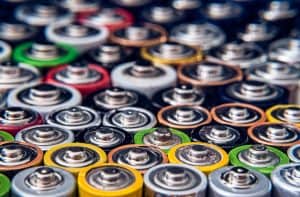
Low Melting Point Metals for Casting
May 17, 2023 - Emily Newton
Revolutionized is reader-supported. When you buy through links on our site, we may earn an affiliate commision. Learn more here.
How hot is hot? There’s no standard definition for a low melting point metal, but considering most metals melt at over 1,000°F (537°C), those metals that disintegrate on the stovetop or even in a person’s hand are certainly unique. These metals and their alloys are great for casting, especially when they form a eutectic mixture.
Low Melting Point Metals
The metal with the lowest melting point is mercury at -38°F (-39°C), which is liquid at room temperature. In contrast, tungsten has the highest melting point, only liquefying at 6,191°F (3,422°C). The 15 lowest melting point metals are:
- Mercury: Melts at -38°F (-39°C)
- Francium: Melts at 81°F (27°C)
- Cesium: Melts at 82°F (28°C)
- Gallium: Melts at 86°F (30°C)
- Rubidium: Melts at 104°F (40°C)
- Potassium: Melts at 145°F (63°C)
- Sodium: Melts at 208°F (98°C)
- Indium: Melts at 315°F (157°C)
- Lithium: Melts at 356°F (180°C)
- Tin: Melts at 450°F (232°C)
- Polonium: Melts at 489°F (254°C)
- Bismuth: Melts at 520°F (271°C)
- Thallium: Melts at 579°F (304°C)
- Cadmium: Melts at 610°F (321°C)
- Lead: Melts at 621°F (327°C)
Many of these low melting point metals commonly make up fusible alloys. However, not all are suitable for casting.
Qualities of Low Melting Point Metals for Casting
Some metals, like polonium and francium, are extremely radioactive. Mercury and lead are toxic and too dangerous to use for many casting applications. Therefore, just because a metal has a low melting point doesn’t mean it’s useful for casting.
Some useful properties of low melting point metals for casting — depending on the application — can include a high enthalpy of fusion, low volume changes, high thermal conductivity and low wettability. Other properties people typically value in metals for casting include high diffusivity, high corrosion resistance and low flammability. It’s rare for someone to want their metal sculptures or car parts to catch fire.
Another useful chemical property of many alloys is that they’re eutectic. This quality means they have a lower melting point when combined than that of any of their individual constituents. For example, anesthetic drugs lidocaine and prilocaine are both solids at room temperature, but when combined, they form a liquid with a melting point of 61°F (16°C).
Eutectic metal alloys are useful for casting because they require less energy input to melt than their individual components. That translates to less time, money and fuel needed to prepare them for pouring into a mold.
Types of Low Melting Point Metals for Casting
Low-melting alloys typically fall into the following categories:
- Alloys comprised of only alkali metals, which are soft metals that are easily cut
- Gallium-containing alloys that exclude mercury and alkali metals
- Mercury-containing alloys for some industrial applications
- Alloys of tin, lead, bismuth, indium, cadmium, zinc or thallium
Additionally, gallium can be used for casting on its own because of its low toxicity and melting point. Some chemists play practical jokes on unsuspecting guests by serving them tea with a gallium spoon — it instantly melts in contact with the hot liquid. Gallium also destroys many other metals, such as aluminum and copper, on contact.
Examples of Low Melting Point Alloys
Many fusible alloys — those which melt at low temperatures — have specific names or patents.
Field’s Metal
This non-toxic alloy melts at 144°F (62°C). Field’s metal contains 32.5% bismuth, 51% indium and 16.5% tin. Itl is useful for rapid prototyping and small-run die casting, although it is typically more expensive than Wood’s metal or Rose’s metal. Contact with liquid Field’s metal can cause third-degree burns despite its lower-than-average melting point.
Rose’s Metal
Useful for casting, this fusible alloy is made from 50% bismuth, 25% to 28% lead and 22% to 25% tin. Ingesting Rose’s metal is toxic due to the lead content. Its melting point hovers around 212°F (100°C). Many people use it as a pipe filler material and as solder for cast iron railings.
Wood’s Metal
This eutectic alloy is toxic to touch or breathe near, but it’s useful for casting custom metal parts. Some people use it to make metal inlays or casts of hard-to-duplicate keys. The alloy is comprised of 50% bismuth, 26.7% lead, 13.3% tin and 10% cadmium by mass. It melts at 158°F (70°C).
Cerrosafe
Cerrosafe is a mixture of 42.5% bismuth, 37.7% lead, 11.3% tin and 8.5% cadmium. Many people use it for making reference castings due to its thermal expansion properties during cooling. Cerrosafe contracts for the first half hour, which makes it easy to remove from a mold. It then expands over the next several days. It melts between 158°F (70°C) and 190°F (88°C).
Cerrolow 136
This eutectic alloy initially expands, then shrinks. It’s useful for crafting turbine blades, jet blades, sprinkler heads, sealing adjustment screws and many other mechanical parts. It has a melting point of 136°F (57.8°C) and contains bismuth, lead, indium and tin.
Cerrolow 117
This bismuth-base eutectic alloy is useful for proof casting in die and tool shops, low-temperature soldering and making dental models. It consists of bismuth, lead, indium, tin and cadmium, and it melts at 117°F (47°C), the temperature for which it is named.
What Are Low Melting Point Metals Used For?
Hobbyists who want to make metal sculptures or other objects at home usually aren’t equipped to melt materials like gold, silver or iron. An oven simply isn’t hot enough to liquefy most metals.
Additionally, low melting point metals are useful for casting in plastic molds that would otherwise melt at high temperatures. Since most 3D printers use plastic as a medium, fusible alloys pair well with using a 3D printer to create molds.
Using low melting point metals for casting is also safer overall. Many can still cause severe burns, but gallium, for example, becomes liquid at just 86°F (30°C), making it safe to handle.
Metals That Can’t Stand the Heat
Most metals are known for their high melting points, but there are exceptions. People who want to use metal for casting can take advantage of low melting point materials for added safety, convenience and compatibility with 3D-printed or handcrafted plastic molds.
Revolutionized is reader-supported. When you buy through links on our site, we may earn an affiliate commision. Learn more here.
Author
Emily Newton
Emily Newton is a technology and industrial journalist and the Editor in Chief of Revolutionized. She manages the sites publishing schedule, SEO optimization and content strategy. Emily enjoys writing and researching articles about how technology is changing every industry. When she isn't working, Emily enjoys playing video games or curling up with a good book.




